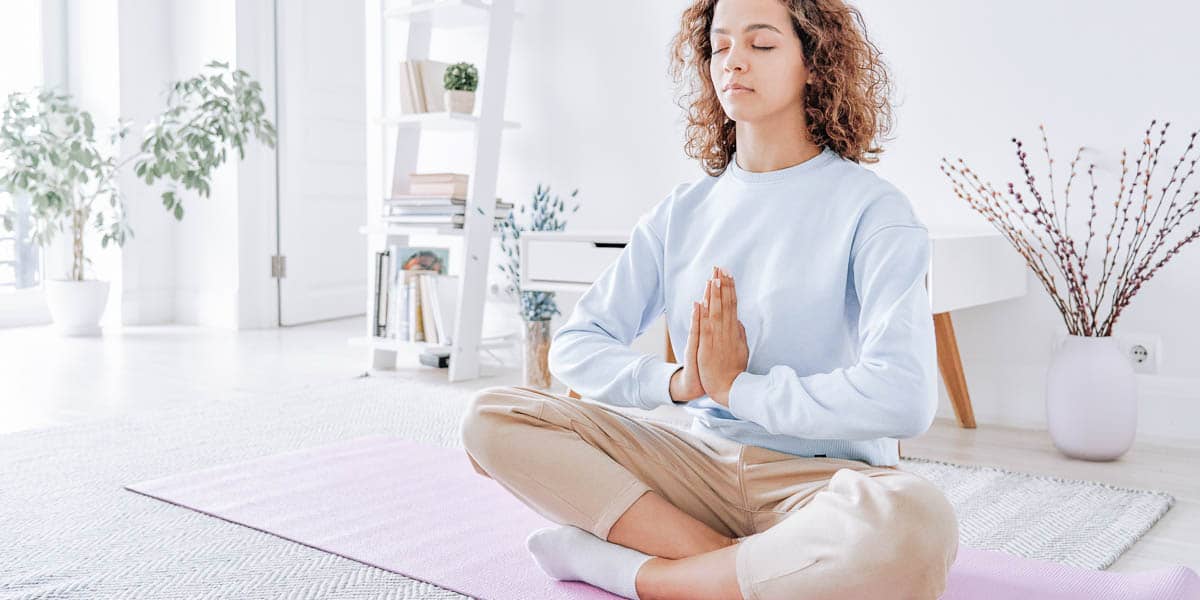4 Effective Tools for Managing Anxiety during Divorce

- Calm your nervous system
- Challenge your anxiety-provoking thoughts
- Halt emotional flooding and distract negative thinking
"The cost of living here is insane. It's just never going to be possible for us to buy a house in this city!"
"I'm freaking out about this upcoming meeting with my boss – something tells me I'm going to get fired."
"I'm not getting any younger and it seems like all the great ones are taken. What if it's too late for me to meet a partner?"
"It seems like every time I turn on the news, someone else has died of cancer. I'm super scared it's just a matter of time for me."
Does any of this sound familiar? Or do you have your own custom-tailored version of the what-if worries? If so, you're not alone. Anxiety is a normal and natural human emotion that everyone experiences at times. And, like with most things in life, anxiety exists on a spectrum – from butterflies in your stomach before speaking up in a meeting to a full-blown panic attack when faced with getting on an airplane – the degree and impact and triggers of anxiety look different for all of us.
Bottom line: You don't get out of this human experience without dealing with anxiety. And while anxiety may be unavoidable to a certain extent, you can definitely cultivate some tools to help you more effectively manage and deal with it so it doesn't impact your daily life so strongly or so negatively.
Need guidance? Below I'm outlined four of my favorite and most effective tools to ease and manage the everyday anxiety you may be experiencing in your own life.
What is anxiety?
Anxiety, according to the American Psychological Association, is "an emotion characterized by feelings of tension, worried thoughts and physical changes like increased blood pressure." That's a fine definition, but it also sounds a bit like fear. So how do you distinguish them? One of the ways I describe and distinguish anxiety from fear for my clients is through this example:
Fear is what happens when you're crossing the crosswalk just outside of my offices and a car comes barreling around the corner and is 10 feet away from hitting you. That surge of energy through your body is plain old primal fear. Anxiety is what happens when you're crossing that same crosswalk and you see a car 20 blocks away and you start worrying if you'll be able to cross the crosswalk in time and if that car will hit you if you don't. Anxiety is fear of perceived threats in the future. Fear is a response to actual threat in the present. Both have physiological impacts. But one is definitely more head-driven. That's anxiety.
Again, we ALL feel anxious from time to time. Anxiety basically tries to scan our lives and futures for harm and warns us when we need to take action to protect ourselves. And while everyday anxiety is normal and natural, when anxiety begins to feel uncontrollable, unmanageable, or starts to interfere with your daily activities, it may be time to seek out support from a licensed mental health or medical professional for support assessing and manage what may be more than normal, everyday anxiety.
According to the Anxiety and Depression Association of America, anxiety disorders are the most common mental illnesses in the country, affecting as many as 40 million people, or 18% of the population. So bottom line: anxiety disorders impact a lot of us.
CAVEAT: If you suspect you may be dealing with an anxiety disorder versus occasional, everyday anxiety, please reach out and get professional support. The tools I'm about to share with you are great, but no substitute for personalized, one-on-one care from a skilled professional.
So without further ado, let's talk about some of my favorite tools that I use as a psychotherapist to help my clients manage this very universal human experience called anxiety.
Tool 1: Ground yourself and calm your nervous system
When you're feeling anxious, your autonomic nervous system (ANS) is aroused and activates your fight, flight, or freeze impulses, catalyzing a whole cascade of physiological symptoms throughout your body. One of the ways you can begin to calm your nervous system and ease your anxiety is through some physical grounding and breath-driven self-soothing. A tool I've found to be incredibly effective is a simple presence and breathing exercise:
Sit comfortably in a chair or on the couch. Let your eyes close and rest your hands on your legs or on the furniture in whatever way feels comfortable to you. Slowly, and with your lips slightly open, begin taking a deep breath in, pushing your lower abdomen out with air, bringing oxygen to the bottom of your lungs. As you breathe in, notice your feet on the floor, your butt on the cushion, your back against the furniture. On your exhale, release your breath slowly – a few counts longer than your inhale – and continue bringing your awareness to any sensations or sounds you notice – maybe your fingers on the fabric of your jeans, the sound of traffic outside, the breeze coming in through the window ... Breathe in and breath out slowly, noticing all the slight sensations around you for 10-15 slow, mindful breaths, allowing your body to relax and your mind to center. And finally, when you're ready, come back to the room.
The benefit of this particular tool is that it helps bring oxygen to our brain and calms our autonomic nervous system, allowing us to relax and access more parts of ourselves and to think and act from a more grounded, integrated place.
Tool 2: Untwist your thinking and challenge your anxiety-provoking thoughts
If you pay attention to what you're saying to yourself when you catch yourself feeling anxious, I'm going to guess you're probably saying something scary to yourself. Again, anxiety scans our lives and futures and tries to warn us of possible threats, so it's pretty masterful in triggering scary thoughts.
One of my other favorite tools, when my clients are struggling with scary, catastrophic future-oriented thoughts, is to have them untwist their thinking with a version of questioning informed by The Work by Byron Katie. Byron Katie is a spiritual teacher, author, and creator of The Work, which, according to her website, is "a way of identifying and questioning the thoughts that cause all the anger, fear, depression, addiction, and violence in the world."
The Work is available for free on her website and while you can review all the steps of her process there, what I have my clients do is a simplified version of her process consisting of identifying and naming the anxiety-provoking thought, asking questions to test its reality, and turning the thought inside out by finding four reasons why that thought may not be fully true.
For example, a woman is anxious about being back on the dating scene and believes "I'm too old to find love at this point." This thought is causing her a lot of anxiety, stress, and grief, so we decide to challenge her thoughts:
Therapist: "So you believe "I'm too old to find love at this point"?"
Client: "Yes, absolutely!"
Therapist: "Is that true?"
Client: "Well yeah, it feels true!"
Therapist: "But can you absolutely, 100% beyond a shadow of a doubt concretely know that you're too old to find love?"
Client: "Well no, I guess I can't know with 100% accuracy."
Therapist: "Good noticing. Okay, let's unpack and untwist this thought. What's the opposite of that thought, 'I'm too old to find love?'"
Client: "The opposite would be, 'I'm not too old to find love.'"
Therapist: "Great, can you give me three examples, even tiny ones, why that opposite thought may in fact be true?"
Client: "Well, I have a girlfriend who met her husband at age 43 after her divorce and they're now one of the happiest couples I know. So if she can do it maybe I can, and that's one reason why my thought may not be true. It may not be true because people still fall in love in nursing homes all over the world and they're waaaaay older than me. And I may not be too old for love because I've been getting a lot of people reaching out to me on Match and my age is clearly listed there, so maybe it's not so big of an issue as I thought."
Therapist: "How do you feel when you think about those reasons why you may not be too old to find love?"
Client: "I feel less panicky. I feel a little more hopeful."
When you challenge the truth of the thoughts that are creating your anxiety and literally untwist them by finding reasons why the opposite might be true, you can create a bit more flexibility in your thinking. And since thoughts can generate feelings, when you create more spaciousness and flexibility in your thinking, you can often ease your anxiety.
Tools 3 and 4: Halt emotional flooding through mental distraction
Have you ever been so wrapped up in your anxiety that you started to become emotionally flooded? Slightly short of breath, totally in your story, detached from the room you're sitting in and the person you're with because of the intensity of your feelings? You may have been emotionally flooded.
When you're anxious and perceiving threats, your autonomic nervous system is aroused and your body becomes flooded with a cocktail of adrenaline and cortisol. This can make it hard to think clearly and maintain focus and react rationally. This is emotional flooding. Two ways you can interrupt this flooding and help yourself get centered and present include the following tools, both of which were inspired by my understanding of Cognitive Behavioral Therapy.
Counting colors
If you catch yourself flooding or perhaps just caught in the loop of an anxiety-provoking thought, tell yourself to look around you in whatever room or environment you may be in, and try to scan the surroundings to find and count aloud five colors of a certain shade. (Hint: I like to have my clients look for colors like purple or gold which are often far harder to find than colors like black and brown which tend to be pretty ubiquitous.) The reason why this tool is effective is that it pulls your mind away from the intensity of the internal experience you're having and forces your attention to be external, literally scanning your surroundings and focusing on a task, which can help reduce the emotional flooding you may have been experiencing.
Counting backward, with a twist
Another great tool to use on yourself (or to use with someone else who is anxious and emotionally flooding) is to count backward. But not just any counting backward – anyone can basically recite 100, 99, 98, 97, etc. without much concentration or effort.
Instead, pick a big number like 637 and then pick an odd, random number like 19.5 and start counting backward to zero from 637 by 19.5. (Did you just frown in concentration reading those words? That's exactly the point!)
Focused efforts to actually try and do that math engages your brain in a way that can distract from the anxiety and flooding you may have been experiencing. Try it next time you're emotionally flooding in any way, whether with anxiety, or maybe anger at a co-worker. It's a subtle, invisible tool that can be wonderful for emotional regulation.
Concluding thoughts about managing your anxiety
Again, I cannot stress this enough: anxiety is a natural and normal emotion that all of us face. We basically don't get out of this human experience without dealing with anxiety. But if you suspect your anxiety is more than occasional, everyday anxiety and it's starting to impact the quality of your life (your relationships, your sleep and health, your job performance, and your ability to move in the direction of your dreams), please get professional help.
The tools I've provided in today's post can be a wonderful support in rounding out your emotional toolkit, but they're no substitute for personalized care from a licensed mental health professional. Reach out and get the support you need. You're so worth it. And until next time, please take very good care of yourself.

Ready to re-discover yourself with coaching or therapy?
Our FREE checklist can help you find the right fit.
Download our checklist of questions to ask a potential therapist or coach today.



